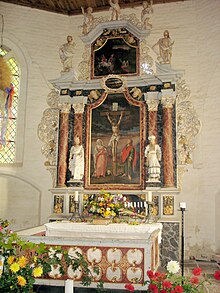Friedrichshagen village church
The village church Friedrichshagen is a brick-Gothic village church in the district Friedrichshagen of the municipality Upahl in the district of Northwest Mecklenburg . It belongs to the parish of Gressow-Friedrichshagen in the Wismar Propstei in the Mecklenburg parish of the Evangelical Lutheran Church in Northern Germany .
history
Friedrichshagen was founded by the German colonist Fredebern (Wredebern) around 1230. The name at that time was Vredeberneshagen and changed from Frebbershagen to Friedrichshagen. After its foundation, the village belonged to the parish of Gressow , but already had a church. In 1265, Prince Heinrich the Pilgrim placed the patronage under the bishop of Ratzeburg. During this time the Teutonic Order settled in the parish, founded the Krankow Commandery in Klein Krankow and also owned six Hufen land in Fredeberneshagen. When the Commandery came in 1355, it was bought by Marquard von Stove. In 1381 the Lords of Stralendorff bought the land, including 2.5 Hufen in Friedrichshagen, which later passed on to the von Negendancks and then to the von Bassewitz . From 1442 the Wehninger line of the Bülows was the owner here. During this time the church was built in its present form. The family is proven here in documents from the time of the Reformation and up to the 18th century. A coat of arms in the church still testifies to the church patronage of the Bülows. Another coat of arms reminds of the noble family von Stenglin , who owned the Bailiwick of Plüschow from 1753 to 1802. Since 1823 Friedrichshagen belonged to the lordly domanium.
The former vicarage of Friedrichshagen is used today as an armory and leisure center. The parish of Gressow-Friedrichshagen is looked after by changing curators pastorally.
At the entrance to the rectory there is a memorial plaque for Pastor Wilhelm Bartelt (1888–1947) who died on August 2, 1947 in special camp No. 9 Fünfeichen .
Building description
The church is a brick building on a field stone base. The nave and the choir form a space that is closed by a flat wooden ceiling. The construction time is indicated differently. Dehio dates the church to the 15th century, in the yearbooks of the Association for Mecklenburg History and Archeology from 1895 the second half of the 14th century is mentioned as the construction time. Eight two-part windows with only a slight ogival shape illuminate the room. The choir area is closed on three sides, with the baroque altar in the middle . The west tower is square and is closed by a hipped roof. Since the height of the tower without the tower roof does not exceed the ridge height of the nave, the church appears as a whole squat. There are buttresses on the nave. A planned design of the church with vaults, the beginnings of which are recognizable, was not implemented, there are no services and corbels.
The church shows clear damage from rising damp in the masonry, especially on the south side in the area of the pulpit.
Furnishing
The altar was created in 1704 by Johannes Friedrich Wilde from Schwerin . It shows a crucifixion painting in the middle essay, of which Schlie writes that it is "inferior". At the base of the altar there is a painting with the Holy Communion. Figures of Moses and Aaron can be seen in front of half-columns as side decorations .
Noteworthy is the Gothic part of a carved altar from the 15th century with the crucifixion scene attached to the north wall, under the cross John and Mary , next to it the saints Catherine and Nicholas . An epitaph painting from 1574 can also be seen on the north wall, it shows Hans von Bülow, who died in 1552, and Katharina von Plessen, who died in 1570.
Heinrich Johann Bülle created the pulpit in the Rococo style . Figurative sculptures adorn the curly basket.
One of what used to be two bells hangs in the tower. It was cast in 1724 by the Lübeck bell caster Laurentius Strahlborn . The bell has a diameter of 1.25 meters and bears the inscription HR. HANS JOCHIM VON BVLOW - VND THE ENTIRE HERITAGE OF THE BLESSED MR LANDRATHS CORDT DETTLOF VON BVLOW: PATRONIES OF FRIEDRICHSHAGEN, CHRISTOPHER HERMAN HOYER PASTOR
organ
The organ on the west gallery was built in 1860 by the organ builder Friedrich Wilhelm Winzer . It has a neo-Gothic prospect with three flat-ended pipe fields; the middle field is set higher, crowned with ornament and bisected vertically by a bar. The tin prospectus pipes delivered for war purposes in 1917 were not replaced by the Mecklenburg organ building until 2015 during the restoration. The slider chest instrument has five registers on one manual . The pedal is attached. The Bourdun 16 'is playable by means of a transmission in the pedal.
|
|
|||||||||||||||||||
Web links
literature
- Friedrich Schlie : Art and historical monuments of Mecklenburg , 1899
- Village and town churches in the Wismar-Schwerin parish , Edition Temmen , Bremen-Rostock, 2001
- Sabine Bock : Plüschow. History and architecture of a Mecklenburg estate. Thomas Helms Verlag , Schwerin 2013, ISBN 978-3-940207-60-9 .
Individual evidence
- ↑ Membership of the community
- ^ Yearbooks of the Association for Mecklenburg History and Archeology
- ↑ H. Ende, C. Molzen, H. Stutz: Churches in Northwest Mecklenburg , edited. from the district of Northwest Mecklenburg, Schwerin, 2005
- ↑ More information about the organ , accessed on November 2, 2019.
Coordinates: 53 ° 49 ′ 23.5 " N , 11 ° 16 ′ 54.5" E





